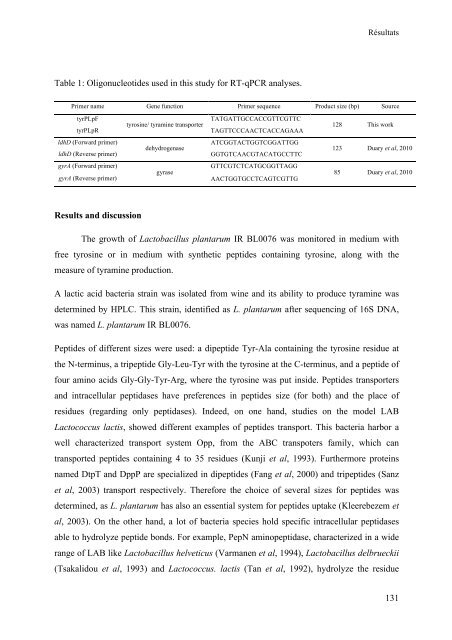THESE Maryse Bonnin Jusserand - Université de Bourgogne
THESE Maryse Bonnin Jusserand - Université de Bourgogne
THESE Maryse Bonnin Jusserand - Université de Bourgogne
Create successful ePaper yourself
Turn your PDF publications into a flip-book with our unique Google optimized e-Paper software.
Table 1: Oligonucleoti<strong>de</strong>s used in this study for RT-qPCR analyses.<br />
Résultats<br />
Primer name Gene function Primer sequence Product size (bp) Source<br />
tyrPLpF<br />
tyrosine/ tyramine transporter TATGATTGCCACCGTTCGTTC<br />
tyrPLpR TAGTTCCCAACTCACCAGAAA<br />
ldhD (Forward primer)<br />
ATCGGTACTGGTCGGATTGG<br />
<strong>de</strong>hydrogenase<br />
ldhD (Reverse primer) GGTGTCAACGTACATGCCTTC<br />
gyrA (Forward primer)<br />
GTTCGTCTCATGCGGTTAGG<br />
gyrase<br />
gyrA (Reverse primer) AACTGGTGCCTCAGTCGTTG<br />
Results and discussion<br />
128 This work<br />
123 Duary et al, 2010<br />
85 Duary et al, 2010<br />
The growth of Lactobacillus plantarum IR BL0076 was monitored in medium with<br />
free tyrosine or in medium with synthetic pepti<strong>de</strong>s containing tyrosine, along with the<br />
measure of tyramine production.<br />
A lactic acid bacteria strain was isolated from wine and its ability to produce tyramine was<br />
<strong>de</strong>termined by HPLC. This strain, i<strong>de</strong>ntified as L. plantarum after sequencing of 16S DNA,<br />
was named L. plantarum IR BL0076.<br />
Pepti<strong>de</strong>s of different sizes were used: a dipepti<strong>de</strong> Tyr-Ala containing the tyrosine residue at<br />
the N-terminus, a tripepti<strong>de</strong> Gly-Leu-Tyr with the tyrosine at the C-terminus, and a pepti<strong>de</strong> of<br />
four amino acids Gly-Gly-Tyr-Arg, where the tyrosine was put insi<strong>de</strong>. Pepti<strong>de</strong>s transporters<br />
and intracellular peptidases have preferences in pepti<strong>de</strong>s size (for both) and the place of<br />
residues (regarding only peptidases). In<strong>de</strong>ed, on one hand, studies on the mo<strong>de</strong>l LAB<br />
Lactococcus lactis, showed different examples of pepti<strong>de</strong>s transport. This bacteria harbor a<br />
well characterized transport system Opp, from the ABC transpoters family, which can<br />
transported pepti<strong>de</strong>s containing 4 to 35 residues (Kunji et al, 1993). Furthermore proteins<br />
named DtpT and DppP are specialized in dipepti<strong>de</strong>s (Fang et al, 2000) and tripepti<strong>de</strong>s (Sanz<br />
et al, 2003) transport respectively. Therefore the choice of several sizes for pepti<strong>de</strong>s was<br />
<strong>de</strong>termined, as L. plantarum has also an essential system for pepti<strong>de</strong>s uptake (Kleerebezem et<br />
al, 2003). On the other hand, a lot of bacteria species hold specific intracellular peptidases<br />
able to hydrolyze pepti<strong>de</strong> bonds. For example, PepN aminopeptidase, characterized in a wi<strong>de</strong><br />
range of LAB like Lactobacillus helveticus (Varmanen et al, 1994), Lactobacillus <strong>de</strong>lbrueckii<br />
(Tsakalidou et al, 1993) and Lactococcus. lactis (Tan et al, 1992), hydrolyze the residue<br />
131

















